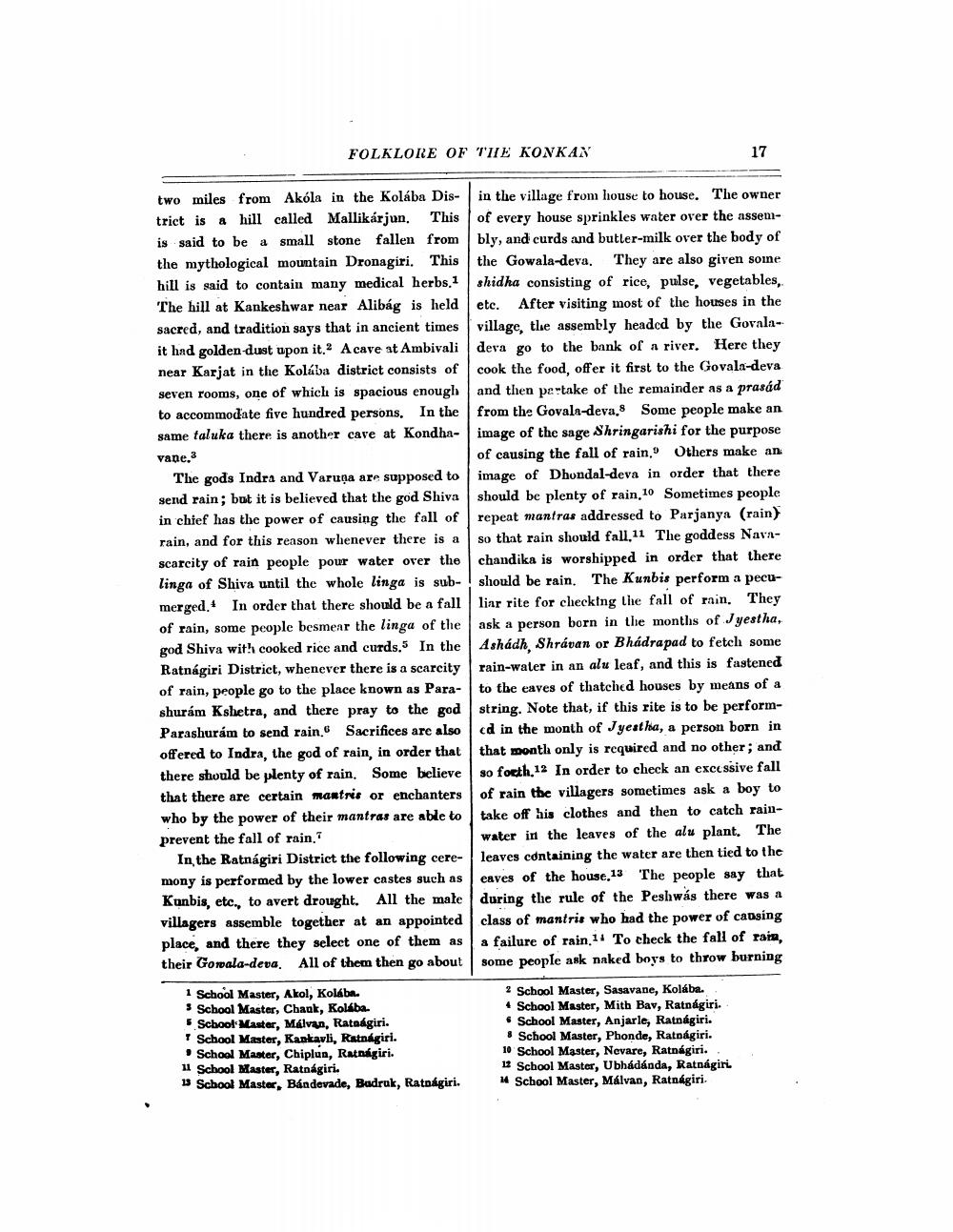________________
FOLKLORE OF THE KONKAN
two miles from Akóla in the Kolába Dis- trict is a hill called Mallikarjun. This is said to be a small stone fallen from the mythological mountain Dronagiri. This hill is said to contain many medical herbs.1 The hill at Kankeshwar near Alibág is held sacred, and tradition says that in ancient times it had golden-dust upon it.? A cave at Ambivali near Karjat in the Kolába district consists of seven rooms, one of which is spacious enough to accommodate five hundred persons. In the same taluka there is another cave at Kondhavane.3
The gods Indra and Varuna are supposed to send rain; but it is believed that the god Shiva in chief has the power of causing the fall of rain, and for this reason whenever there is a scarcity of rain people pour water over the linga of Shiva until the whole linga is sub- merged. In order that there should be a fall of rain, some people besmear the linga of the god Shiva with cooked rice and curds. In the Ratnagiri District, whenever there is a scarcity of rain, people go to the place known as Para- shurám Kshetra, and there pray to the god Parashurám to send rain. Sacrifices are also offered to Indra, the god of rain, in order that there should be plenty of rain. Some believe that there are certain mantris or enchanters who by the power of their mantras are able to prevent the fall of rain,
In the Ratnagiri District the following ceremony is performed by the lower castes such as Konbis, etc., to avert drought. All the male villagers assemble together at an appointed place, and there they select one of them as their Gowala-deva. All of them then go about
in the village from house to house. The owner of every house sprinkles water over the assembly, and curds and butter-milk over the body of the Gowala-deva. They are also given some shidha consisting of rice, pulse, vegetables, etc. After visiting most of the houses in the village, the assembly headed by the Govaladeva go to the bank of a river. Here they cook the food, offer it first to the Govala-deva and then partake of the remainder as a prasád from the Govala-deva. Some people make an image of the sage Shringarishi for the purpose of causing the fall of rain.9 Others make an image of Dhondal-deva in order that there should be plenty of rain.10 Sometimes people repeat mantras addressed to Parjanya (rain) so that rain should fall 11 The goddess Navachandika is worshipped in order that there should be rain. The Kunbis perform a peculiar rite for checking the fall of rain. They ask a person born in the months of Jyestha, Ashadh, Shrávan or Bhadrapad to fetch some rain-water in an alu leaf, and this is fastened to the eaves of thatched houses by means of a string. Note that, if this rite is to be performed in the month of Jyestha, a person born in that month only is required and no other, and so forth. 12 In order to check an excessive fall of rain the villagers sometimes ask a boy to take off his clothes and then to catch rainwater in the leaves of the alu plant. The leaves containing the water are then tied to the eaves of the house. 13 "The people say that during the rule of the Peshwas there was a class of mantris who had the power of causing a failure of rain. 11 To check the fall of rain, some people ask naked boys to throw burning
1 School Master, Akol, Kolába. * School Master, Chank, Kolába 5 School Master, Málvan, Ratnagiri.
School Master, Kankavli, Ratnagiri. • School Master, Chiplun, Ratnagiri. 1 School Master, Ratnagiri. 13 School Master, Bándevade, Budruk, Ratnagiri.
2 School Master, Sasavane, Kolába. • School Master, Mith Bav, Ratnagiri.
School Master, Anjarle, Ratnagiri. * School Master, Phonde, Ratnagiri. 10 School Master, Nevare, Ratnágiri. 12 School Master, Ubhádánda, Ratnagiri 2 School Master, Málvan, Ratnagiri.




